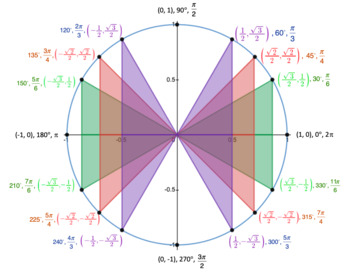Jet's smART Math
22 Followers
Grade Levels
9th - 12th, Higher Education, Adult Education
Subjects
Resource Type
Standards
CCSSHSF-TF.A.2
CCSSHSF-TF.A.3
CCSSHSF-TF.A.4
CCSSHSF-TF.B.7
CCSSMP5
Formats Included
- Portable Network Graphics
Pages
1 page
Jet's smART Math
22 Followers
Description
Download this color unit circle for your students. The colorful representation will enable them to make connections between reference angles and their coordinates.
All reference angles (in radians and in degrees) and ordered pairs are labeled.
The triangles are color coded with their descriptive information.
Desmos was used to draw the basic circle and triangles. The labels on the angles were added using Word.
Total Pages
1 page
Answer Key
N/A
Teaching Duration
N/A
Report this resource to TPT
Reported resources will be reviewed by our team. Report this resource to let us know if this resource violates TPT’s content guidelines.
Standards
to see state-specific standards (only available in the US).
CCSSHSF-TF.A.2
Explain how the unit circle in the coordinate plane enables the extension of trigonometric functions to all real numbers, interpreted as radian measures of angles traversed counterclockwise around the unit circle.
CCSSHSF-TF.A.3
Use special triangles to determine geometrically the values of sine, cosine, tangent for π/3, π/4 and π/6, and use the unit circle to express the values of sine, cosine, and tangent for π–𝘹, π+𝘹, and 2π–𝘹 in terms of their values for 𝘹, where 𝘹 is any real number.
CCSSHSF-TF.A.4
Use the unit circle to explain symmetry (odd and even) and periodicity of trigonometric functions.
CCSSHSF-TF.B.7
Use inverse functions to solve trigonometric equations that arise in modeling contexts; evaluate the solutions using technology, and interpret them in terms of the context.
CCSSMP5
Use appropriate tools strategically. Mathematically proficient students consider the available tools when solving a mathematical problem. These tools might include pencil and paper, concrete models, a ruler, a protractor, a calculator, a spreadsheet, a computer algebra system, a statistical package, or dynamic geometry software. Proficient students are sufficiently familiar with tools appropriate for their grade or course to make sound decisions about when each of these tools might be helpful, recognizing both the insight to be gained and their limitations. For example, mathematically proficient high school students analyze graphs of functions and solutions generated using a graphing calculator. They detect possible errors by strategically using estimation and other mathematical knowledge. When making mathematical models, they know that technology can enable them to visualize the results of varying assumptions, explore consequences, and compare predictions with data. Mathematically proficient students at various grade levels are able to identify relevant external mathematical resources, such as digital content located on a website, and use them to pose or solve problems. They are able to use technological tools to explore and deepen their understanding of concepts.


